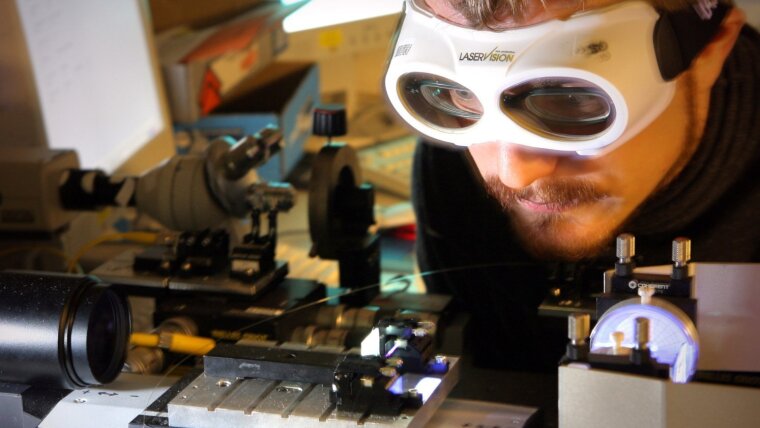
apl. Prof. Michael Schmitt.
Image: Anne Günther (University of Jena)apl. Prof. Dr. Michael SCHMITT
Email: m.schmitt@uni-jena.de
Phone: +49 3641-9-48367
Apl. Prof. Michael Schmitt is research associate at the Institute of Physical Chemistry at the chair for Physical Chemistry of Prof. Popp. He serves as assistant Editor of the Journal of Biophotonics.
Research Areas
Dr. Schmitt’s research interests are focused on linear and nonlinear laser microspectroscopy for:
- Biomedical and life sciences analysis
- Characterization of the interaction between low molecular molecules and biological target molecules
- Derivation of structure-property and structure dynamic relationships of biomolecules and innovative materials
Teaching Fields
Dr. Schmitt teaches classes in fundamental physical chemistry (B.Sc. and M.Sc. Chemistry) and spectroscopy and imaging (M.Sc. Chemistry, M.Sc. Chemical Biology).
Research Methods
The laboratories run by Dr. Schmitt at the chair of Prof. Popp offer possibilities for linear and non-linear laser spectroscopy by utilizing the following equipment:
- Resonance Raman spectroscopy
- Non-linear multimodal imaging combining:
- Coherent anti-Stokes Raman (CARS) microscopy
- Stimulated Raman scattering (SRS) microscopy
- Second harmonic generation (SHG) imaging
- Multi-photon excited autofluorescence imaging
- Multi-photon excited fluorescence life-time imaging microscopy (FLIM)
Recent Research Results
Multimodal nonlinear microscopy has matured during the past decades to one of the key imaging modalities in life science and biomedicine due to its unique capabilities of label-free visualization of cell and tissue structure and chemical composition, high depth penetration, intrinsic 3D sectioning, diffraction limited resolution and low phototoxicity. Within the last years the non-linear imaging unit within the chair of Prof. Popp headed by Dr. Schmitt utilized the combination of various non-linear imaging modalities like coherent anti-Stokes Raman scattering (CARS), multi-photonexcited fluorescence (MPEF) or second harmonic generation (SHG) to study disease processes in organs like e.g. liver [1,2,3] or chemical processes in plants [4]. Furthermore, new technological concepts of image acquisition and sample illumination to further speed up the image acquisition have been realized [5].
Another focus of the work of Dr. Schmitt is the spectroscopic characterization of innovative materials like e.g. self-healing polymers. The main goal of this work, which was carried out in close collaboration with the group of Prof. Schubert, was the characterization of the healing mechanism of self-healing polymers on a molecular level, which is an important prerequisite for the targeted development of self-healing materials [6-9]. In this context it could be shown for the first time that the healing of a crack in a self-healing polymer observed by CARS microscopy takes place on a different time scale than the simultaneous observation of crack healing by conventional reflection microscopy [8]. These investigations, which for the first time allowed for the simultaneous acquisition of morphological reflection and molecular CARS images, show very well that it is not sufficient to characterize the healing „only“ morphologically, but that molecular aspects, which can only be detected by molecular spectroscopic methods such as CARS microscopy, play a decisive role.
[1] Legesse et al., Chem. Phys. Chem. 17, 4043 (2016).
[2] Yarbakht et al., Anal. Chem. 91, 11116 (2019).
[3] Matuszyk et al., BBA Molec. Basis of Dis. 1866, 165763 (2020).
[4] Legesse et al., Chem. Phys. Chem. 19, 1048 (2018).
[5] Legesse et al., Opt. Lett. 42, 183 (2017).
[6] Geitner et al., Phys. Chem. Chem. Phys. 18, 17973 (2016).
[7] Tepper et al., Angew. Chem. Int. Ed. 56, 4047 (2017).
[8] Geitner et al., Chem. Eur. J. 24, 2493 (2018).
[9] Geitner et al., J. Phys. Chem. A 122, 2677 (2018).
[10] Stiebing et al. Neurophotonics 6, 041106 (2019).
Material- & Biophotonics Group
